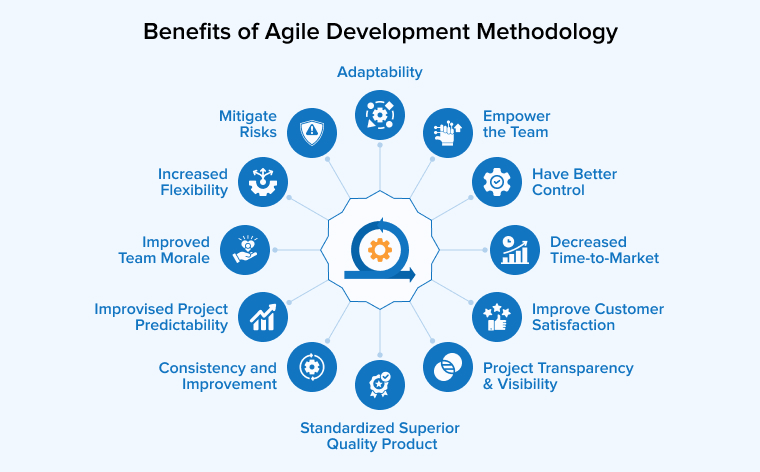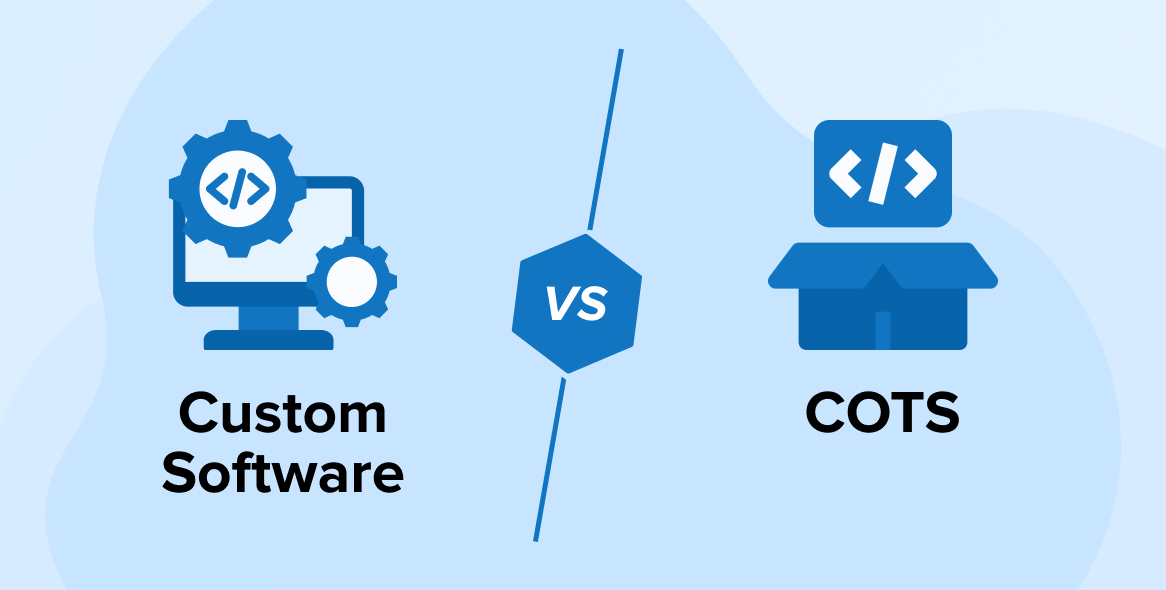
In today’s time, custom software development companies use the latest project management methodologies to stay ahead of their competition and organize development processes that ultimately help them offer top-notch solutions to their clients. One such methodology is Agile. It enables the developers to break the project into smaller parts and get the client’s feedback at every stage of the development process. Besides this, there are many different benefits of Agile methodologies that enable software engineers to create solutions of the best quality. To know more about the benefits of Agile methodologies, let’s go through this blog.
1. What is Agile Methodology?

The Agile methodology is an approach for managing projects that offers continuous development, collaborative work among team members, and ongoing review and assessment. The entire development process is broken down into different stages, allowing separate teams to work on separate tasks. Agile teams can quickly tackle small tasks instead of spending hours or days to create a thorough plan that could or might not be appropriate for the project’s execution.
The Agile approach is based on the principle of prioritizing client involvement from the first phase of the software development life cycle. Involving the customers at every stage of the process is crucial to ensuring that their needs and requirements are met in the final output. Clients can save both time and money by using this strategy, which allows them to test and approve the product at every step of development. Agile is a great model for many teams across various sectors, as it allows quick fixes in case of problems or delays.
2. Benefits of Agile Development Methodology

The Agile technique applies a multi-stage approach to break down large projects into more manageable parts. It emphasizes collaboration with stakeholders and encourages continuous improvements at each step. To produce a high-quality product within the set budget, teams might benefit from using Agile approaches to manage their workload and complete tasks better.
When it comes to managing projects, the Agile technique has several benefits. Some of these are listed below.
2.1 Standardized Superior Quality Product
Agile methodology has been delivering outstanding results which include high-quality software and applications developed at reduced cost. The Agile software development team does not strive to develop all product features at once when utilizing Agile methods, unlike the traditional project management approach. Instead, it first divides the project into manageable chunks and executes them one by one throughout all the development phases.
So when you use Agile methodology, it allows you to undertake testing after each iteration and solicit feedback from the product owner. This feedback will then be implemented in the development phase. This strategy assists the Agile team in identifying expectation mismatches early in the development process, as well as finding and fixing errors promptly.
Working on these incremental releases will ensure that each iteration results in a thoroughly tested and functional product. As a result of Agile project management methodology, the quality of the product improves.
2.2 Improve Customer Satisfaction
Customer satisfaction is the first Agile principle. The top agenda is to satisfy the customers through early and continuous delivery of valuable software solutions. The project is not regarded as successful if the customer is dissatisfied with the added features/functions. They do not accomplish their business goal, regardless of how good the code is. Each sprint should add value.
The customers, particularly internal stakeholders who will utilize the final product/service, are prioritized over processes in Agile. Thus, if you consider their feedback, the process will be easier and more convenient. Customer feedback is incorporated into the process to continuously enhance quality.
2.3 Mitigate Risks
In Agile methodology, the risk factor is minimal due to continuous iterations that help businesses minimize failures and flaws. Risk management is practiced throughout the product development cycle. Once the scrum team identifies risks, they immediately move to prepare an action plan. However, due to the default style of iterations and corrections, as well as the overall project level, action plans are implemented and monitored continually. At the outset of the project, risks are identified at a higher level. Before this, the top-priority risks were analyzed and mapped using multiple checklists. This allows businesses to see what works for them and what does not. Agile methodology eliminates the element of uncertainties that is present in traditional techniques.
However, product testing is delayed until the end in traditional methods, leaving the team unsure if the product meets requirements.
2.4 Have Better Control
When you have different teams working on different aspects of the software, communication, and transparency are the key aspects of a project’s overall development. But it is difficult to obtain meticulous control especially when evaluating the details from the C-suite or businessmen. However, one advantage of the Agile project management methodology is greater control over project development.
In Agile software development, businesses conduct daily sprint meetings to maintain visibility into how a project is progressing and the individual tasks each team member has completed. This increases project transparency by expanding the number of information sources.
Finally, if you have control over your project, all your business needs to do is effectively manage data and monitor daily tasks. There are apps as well that help you trace any projects more efficiently. Apps such as Slack, Trello, Asana, and similar others.
2.5 Improvised Project Predictability
The predictability of projects improves due to the shorter software project cycle. Sprints are short intervals of time in which Agile teams operate. The Agile method functions on this principle of shorter sprints. These predicted lengths enable all the project managers to easily monitor team performance and allocate resources accordingly. The estimated expenses are often easier to anticipate for shorter periods than for long-term projects. You can easily make an apt estimation with predictive analytics.
2.6 Decreased Time-to-Market
Often when software applications are built using Agile approaches, they work efficiently. This is primarily due to Agile’s task prioritizing. Yes, Agile has this feature to prioritize work according to needs. During the Product Design phase, the team can break the end product into smaller chunks. This divides the project into smaller, manageable parts with essential functionalities for the launch The benefit of using the Agile method is that it considerably decreases go-to-market time. This enables you to successfully capitalize on the chance. In some instances, you can use it to gain the first-mover advantage.
2.7 Empower The Team
Teams working on Agile principles are self-organizing and self-managing. They do not need any lead to get things done. Everyone is on the same page and they have a lot more autonomous tasks that can be handled without the need for constant supervision. So, they take responsibility for their duties and work together to overcome hurdles.
Self-management has been shown to increase team members’ creativity, leading them to be more innovative and take pride in their jobs (and their work outcomes). Self-management and an Agile approach encourage personal and team growth by allowing them to share experiences and learn daily as part of their work environment.
2.8 Consistency and Improvement
When you work in Agile teams, there is a team meeting every day to understand the timeline of the project and how to alter the plan to achieve it. In this meeting, the team gathers and retrospects the whole project developed till now to understand what has worked well and what needs to be improved. The purpose is to establish a safe environment in which mistakes may be identified and avoided in the future. This practice originates from the spirit of continuous improvement, a fundamental principle of the Agile Manifesto.
2.9 Project Transparency & Visibility
An Agile approach offers clients unique opportunities to be part of the project, from feature prioritization to iteration strategic decisions; making meetings for frequent software builds incorporating new features. However, in exchange for this extra advantage of transparency, clients must recognize that they are viewing a work in progress.
2.10 Increased Flexibility
The ability to quickly adjust to new settings is a key component of the Agile approach, which is advantageous across all sectors. As businesses grow, their complexity rises. Thus, corporations prioritize speed in order to remain competitive; nevertheless, speed does not guarantee the development of a more effective system. This is why an increasing number of companies are embracing Agile methods.
2.11 Improved Team Morale
Agile teams have more freedom and control over their decisions since they are self-managing and self-organizing. When sponsors and upper management try to get involved, the project manager steps in to defend the team. Members develop their existing abilities and acquire new ones in project management thanks to the interdisciplinary nature of the teams. Their team can work together more effectively since they meet often to review progress and problems. Additionally, Agile teams are small enough to foster community and allow for more adaptable organizational structures.
2.12 Adaptability
Agile prioritizes adaptability. Even for the last-minute changes, Agile teams are quick to respond and adjust with little to no downtime. Due to the fluid nature of project deliverables, teams are free to reevaluate their strategies and priorities in light of changed objectives. Teams that can quickly adjust to new circumstances are more effective at meeting the evolving needs of their clients.
3. Conclusion
Finally, we now know that Agile is the simplest and go-to method for software development. The benefits are not just restricted to the software development team but also the clients in a number of ways, we haven’t even imagined. Agile methodology assists project teams in dealing with many of the most typical project stumbling blocks in a more controllable environment. This makes Agile preferable among businesses and developers that makes them go for it because of the discussed perks it offers.






Agile is preferred over other methods because it makes the managers’ job easier and allows them to have greater control over their projects. Agile development principles improve overall team effectiveness, project quality and providing greater value to the customer. The performance indicators used by Agile teams in the estimation of time and cost are more accurate and relevant as compared to methodologies.